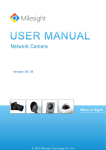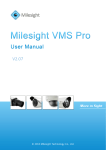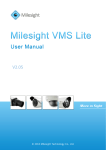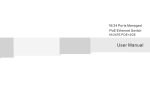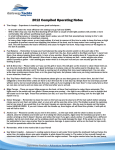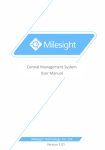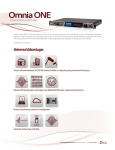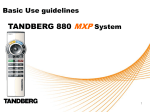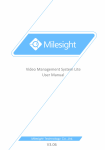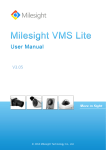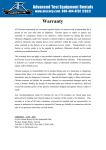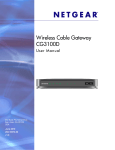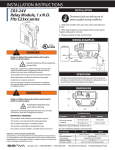Download Version: V5.04
Transcript
User Manual Version: V5.04 www.milesight.com User Manual Chapter III Accessing the Network Camera 3.1 Assigning An IP Address The camera must be assigned an IP address to be accessible. The default IP address of Milesight network camera is 192.168.5.190. The default user name is admin, and password is ms1234. You can either change the IP address of the camera via IPCTools or manually. Please connect the camera in the same LAN of your computer. 3.1.1 Assigning An IP Address Using IPCTools IPCTools is a software tool which can automatically detect multiple online Milesight network cameras connected in the LAN, set IP addresses, and manage firmware upgrades. It’s recommended when assigning IP addresses for multiple cameras. Step 1: Install IPCTools (The software could be downloaded from CD.) Step 2: Start IPCTools, and the device information including IP address, MAC address, Port number, Netmask, and Gateway of all Milesight network cameras will be displayed. Details are shown as Figure 3-1. Figure 3-1 Step 3: Select a camera or multiple cameras according to the MAC address. www.milesight.com 12 User Manual Figure 3-2 Select single camera Figure 3-3 Select multiple cameras Step 4: Type the User Name and Password (if they are not default value.) www.milesight.com 13 User Manual Figure 3-4 Step 5: Change the IP address or other network values, and then click “Modify” button. Figure 3-5 Step 6: Change the IP address successfully. www.milesight.com 14 User Manual Figure 3-6 Change IP address successfully Step 7: By double clicking the selected camera, you can access the camera via web browser directly. The Internet Explorer window will pop up. www.milesight.com 15 User Manual Figure 3-7 3.1.2 Assign An IP Address Manually If the network segments of the computer and that of the camera are different, please follow the steps to change the IP address: Step 1: Change the IP address of computer to 192.168.5.0 segment. a. Start-> Control Panel->Network and Internet Connection->Network Connection->Local Area Connection, and double click it. (See Figure3-8) Figure 3-8 b. Click “Advanced”, and then click “IP settings”->”IP address”->”Add” (See Figure 3-9). In the popup window, enter an IP address with a same segment with Milesight network camera (e.g.: 192.168.5.61, but please note that this IP address shall not conflict with the IP address on the existing network), see Figure 3-9. www.milesight.com 16 User Manual Figure 3-9 Step.2: Start the browser. In the address bar, enter the default IP address of the camera: http://192.168.5.190. Step.3: Enter the user name and password when the login page appears. Default user name: admin Default password: ms1234 www.milesight.com 17 User Manual Figure 3-10 Step.4: After login, please select the “Configuration””Basic Settings””Network”. The Network Settings page appears. (Shown as Figure 3-11) Figure 3-11 www.milesight.com 18 User Manual Step.5: Change the IP address or other network values. Then click “Save” button. Step.6: The change of default IP address is completed. 3.2 Accessing from the Web Browser The camera can be used with the most standard operating systems and browsers. The recommended browsers are Internet Explorer, Firefox, Chrome, Safari. 3.2.1 Access over IE Browser Launch the IE browser and enter the IP address of the camera. Enter the User Name and Password and click “Login”. Note: The default user name is “admin”, password is “ms1234” At the first time to log on the device, the browser will prompt to install controls, please click 'Click here to download and install controls manually' as Figure 3-12. Figure 3-12 Follow the prompts to install the controls, when it`s finished, it will pop out a window as Figure 3-13. Please click 'Finish' and refresh the browser, then you will see the video. Figure 3-13 Note: If IE9or higher version browser is used, it is suggested that the Milesight camera web link should be added as a trusted site. See the instructions as below: Step 1: Start the IE9 or higher version browser, and select “Tools”select“Internet Options”. www.milesight.com 19 User Manual Figure 3-14 Step 2: Select “Security””Trusted Figure 3-15 Step 3: Enter the IP address of the camera in the blank and click “Add” www.milesight.com 20 User Manual Figure 3-16 Step4: Enter the IP address. After logging on IP camera`s web GUI successfully, user is allowed to view live video as bellow. Figure 3-17 3.3 Accessing from Milesight VMS (Video Management Software) MilesightVMS(ONVIF compatible) is a handy and reliable application designed to work with IP www.milesight.com 21 User Manual cameras in order to provide video surveillance, recording settings and event management functions. The interface of MilesightVMS is very easy to use, intuitive, with easy access to the most common activities, such as viewing live video, searching through recordings and exporting videos and snapshots. It's able to integrate with other devices through ONVIF and you can connect up to 64 cameras. It is designed to work on Windows XP/7/8/Vista/Server 2000/Server 2008.The software is contained in the CD or could be downloaded from our website www.milesight.com. Please install Milesight VMS; then launch the program to add the camera to the channel list. For detailed information about how to use the software, please refer to user manual of Milesight VMS. Figure 3-18 www.milesight.com 22 User Manual Chapter IV System Operation Guide 4.1 Live Video After logging on the network camera web GUI successfully, user is allowed to view live video as bellow. Figure 4-1 Live view interface Table 4-1 Description of the buttons No. Parameter Description Navigation key is used to control the direction. The rotation key is used for auto-rotation 1 ○ PTZ Control 2 ○ 3 ○ PTZ Speed Image Adjustment PTZ rotation speed control Brightness A brighter scene appears, if a higher level of brightness is chosen ContrastThe difference in color and light between parts of an image Saturation A more vivid scene appears, if a higher level of saturation is chose Sharpness Make image more sharp Noise Reduction Level www.milesight.com Adjust the noise 23 User Manual reduction level Default Settings Restore brightness, contrast and saturation to default settings 4 ○ Click to access the configuration page 5 ○ Choose the Stream to show on the current video window 6 ○ Click to display images in a window size Window size 7 ○ Click to display images in a real size Real size 8 ○ Click to display images in a full-screen Full Screen 9 ○ Recording 10 ○ Alarm When an alarm causes recording, the icon will turn red When enabled, an alarm occurs, the icon will turn red Adjust the focal length of the lens Adjust focus of the lens Adjust the size of IRIS Auxiliary Focus and Lens Initialization 12 ○ / 13 ○ Capture 14 ○ Start Recording 15 ○ Start/Stop live view Click to capture the current image and save to the configured path. Default path is C:VMS\+-1\ IMAGE-MANUAL Click to start recording video and save to the configured path. Default path is C: VMS\+-1\MS_Record. Click again to stop recording Set the saving path for capture and recording Saving Path Settings www.milesight.com 24 User Manual 16 ○ Play Audio 17 ○ Enable Zoom 18 ○ E-PTZ Enable Audio Input/output. It can also be set in Audio configuration page When enabled, you can zoom in on a specific area of video image with your mouse wheel Able to use PTZ to move the position(only support under 720P with MS-C26XX or MS-C36XX) 4.2 Playback Purpose: This section explains how to view the remotely recorded video files stored in the SD cards or the network disks. Steps: 1. Click Playback on the menu bar to enter playback interface. Figure 4-2 Playback interface 2. Select the date and click Search. www.milesight.com 25 User Manual Figure 4-3 Search Video 3. Click to play the video files found on this date. The toolbar on the buttom of playback interface can be used to contrlo playing progress. Figure 4-4 Playback Toolbar Table 4-2 Description of the buttons Button Operation Play Pause Stop Speed down Speed up / On/Off audio / Enable/Disable digital zoom Full screen Note: Drag the progress bar with the mouse to locate the exact playback point.You can also input the time and click www.milesight.com to locate the playback point in the set playback time filed.You can also click 26 User Manual to zoom out/in the progress bar. Figure 4-5 Set Payback Time 4.3 Basic Settings 4.3.1 Video OSD (On Screen Display) content and video time can be displayed to rich the video information. Stream parameters can also be set on this page, to adapt to different network environments and demands. Figure 4-6 On Screen Display(OSD) Parameters Show Video Title Video Title Text Position Show Timestamp Date Position www.milesight.com Function Introduction Check the checkbox to show video title OSD content customized OSD display position on the image Check the checkbox to display date on the image Date display position on the image 27 User Manual Date Format The format of date Figure 4-7 Primary Stream Settings Parameters Video Codec Frame Size Maximum Frame Rate Bit Rate Function Introduction H.264/MPEG-4/MJPEG available (Main stream only support H.264) Options include 5M(2560 × 1920), 3M(2048 × 1536), 1080P(1920× 1080), 2M(1600 ×1200), 1.3M(1280×960), 720P(1280×720),D1 (704×576) Maximum refresh frame rate of per second Transmitting bits of data per second CBR : Constant Bitrate. The rate at which a codec's output data should be Bit Rate Control Profile I-frame Interval consumed is constant VBR : Variable Bitrate. VBR files vary the amount of output date per time segment The option of codec, select Base/Main/High according to your needs Set the I-frame interval to 1~30 Note: The options of Frame Size are variable according to the model selected. www.milesight.com 28 User Manual Secondary Stream Settings Parameters Enable Video Codec Frame Size Maximum Frame Rate Bit Rate Function Introduction Click to enable the secondary steam H.264/MPEG-4/MJPEG available The optional resolutions of the secondary stream depend on theCodec of the primary stream and the secondary stream Maximum refresh frame rate of per second Transmitting bits of data per second CBR : Constant Bitrate. The rate at which a codec's output data should be Bit Rate Control Profile I-frame Interval consumed is constant VBR : Variable Bitrate. VBR files vary the amount of output date per time segment The option of codec, select Base/Main/High according to your needs Set the I-frame interval to 1~30 4.3.2 Image Figure 4-8 www.milesight.com 29 User Manual Figure 4-9 General Settings Parameters Function Introduction Wide Dynamic Range This function enables the capture and display of both bright and dark areas in the same frame, in a way that there aredetails in both areas Off: Disable WDR function On: Enable WDR function Customize: Customize the time when the WDR function will be enabled Exposure Region Outdoor/Indoor Mode Power Line Frequency Smart IR www.milesight.com Full View, Custom, and BLC are selectable Full view: Calculate the full range of view and offer appropriate light compensation Custom: This option enables you to add customized windows as inclusive or exclusive regions manually BLC (Back Light Compensation): This option will automatically add an inclusive region in the middle of the window and give the necessary light compensation Select indoor or outdoor mode according to your needs 60HZ flicker for NTSC mode and 50HZ flicker for PAL mode Gives user an option to turn On/Off the IR LED.Select smart IR on, and the IR LED changes according to the actual luminance. 30 User Manual Exposure Mode Maximum Exposure Time IR-CUT Interval IR-CUT Color Mode Schedule Mode Note: Wide Dynamic Range Auto mode/Customize mode.If you choose customize mode,the camera adjusts the brightness according to the value you set.The higher the value,the brighter the image is. Set the maximum exposure time to 1/5~1/100000 IR-CUT switch time between each mode Choose to turn on or turn off under the mode Here can choose B/W or color mode under Day/Night mode Here you can customize your special demands for different time, then the Day mode and Night mode will switch according to your settings The function is only applicable for models MS-C23XX, MS-C33XX. Figure 4-10 Advanced Settings Parameters Local Display Video Video Orientation Function Introduction Off: Switch off the Video NTSC: Switch video to NTSC standard PAL : Switch video to PAL standard Normal: Remain the image in normal direction Flip Horizontal: Flip the image horizontally Flip vertical: Flip the image vertically Rotating 180°: The images is presented upside down 4.3.3 Audio Audio input and output can work with alarms to achieve various alarm functions. Alarm willbetriggered when there is audio input or play the configured audio when an alarm occurs. www.milesight.com 31 User Manual Figure 4-11 Audio Parameters Function Introduction Enable Audio Check on the checkbox to enable audio feature Audio Mode Enable audio input/output Audio Input Denoise:Set it as On/Off.When you set the function on the noise detected can be filtered Encoding:G711-Ulaw,G711-Alaw and AAC LC are selectable. Input Gain:Input audio gain level ,0-100 Alarm Level:Alarm will be triggered if voice alarm is enabled and input gained volume is higher than the alarm level,0-100 Output Volume The volume of alarm audio output Note: The Audio mode and audio output is only for certain modules. 4.3.4 Network Figure 4-12 www.milesight.com 32 User Manual IP Address Configuration Parameters Enable DHCP Use fixed IP address Function Introduction Get an IP address from the DHCP server automatically IPv4 Address: Address used to identify a network camera on the network IPv4 Subnet Mask: It is used to identify the subnet wherethe network camera is located IPv4 Default Router: The default router address Primary DNS: The DNS Server translates the domain name to IP address IPv6 Mode: Choose different mode for IPv6:Manual/Route Advertisement/ DHCPv6 IPv6 Address: IPv6 Address used to identify a network camera on the network IPv6 Prefix: Define the prefix length of IPv6 address IPv6 Default Router : The default router IPv6 address Other Settings Figure 4-13 Parameters HTTP Enable Function Introduction Start or stop using HTTP HTTP Port Web GUI log on port, the default is 8080 RTSP Port Web GUI log on port via HTTPS, the default is 443 Multicast Group Address ONVIF RTSP Custom Support multicast If you want to remote access the camera via ONVIF, you need to enter your public IP here FTP Port The port of the FTP. Generally it is 21 QoS DSCP The valid value range of the DSCP is 0-63.The bigger the DSCP value is ,the higher the priority is. www.milesight.com 33 User Manual Note:1)DSCP refers to the Differentiated Service Code Point;and the DSCP value is used in the IP header to indicate the priority of the data. 2)A reboot is required for the settings to take effect. 4.3.5 Wi-Fi* Figure 4-14 WI-FI Settings* Parameters WI-FI Status www.milesight.com Function Introduction Connected/Disconnected 34 User Manual SSID Network Mode WIFI source WI-FI option for Manage and Ad-Hoc mode Key Enter the password of WI-FI connection Security Mode Select WI-FI connection security mode Encryption Type WI-FI encryption type Key Password for WI-FI WPS(Wi-Fi Protected Setup) Originally Wi-Fi Simple Config, it’s a network security standard that allow users to easily secure a wireless home network. the goal of the protocol is to allow home users who know little of wireless security and may be intimidated by the available security options to set up Wi-Fi Protected Access, as well as making it easy to add new devices to an existing network without entering long passphrases. PIN Method It’s a personal identification number (PIN) has to be read from either a sticker or the display on the new wireless device. You can add the PIN code to the router or you add the Router PIN code on this camera. Push-Button-Method The user simply has to push a button, either an actual or virtual one, on both the access point and the new wireless client device. Support of this mode is mandatory for access points and optional for connecting devices. Enable WPS Enable or Disable WPS PIN Code Click on the ‘Generate’ to get a code, you need to add this PIN code to the router PBC Connecting Connect via PBC button, click on the PBC button on the router, then click ‘Connect’ button again Enter the router PIN code here, and also with the SSID Use Router PIN Code Note: (1) WI-FI function is only applicable for box and cube cameras if purchased, WPS need supports from WI-FI router. (2) If you use Fixed IP, please set the IP same segment with WI-FI router . www.milesight.com 35 User Manual 4.3.6 Date &Time Figure 4-15 Current System Time Current date &time of the system Set the System Time Parameters Time Zone Daylight Saving time NTP Sync Synchronize with computer time NTP server Encryption Type Manual www.milesight.com Function Introduction Choose a time zone for your location Enable the daylight saving time Regularly updated your time according to the interval time Synchronize the time with your computer Select WI-FI connection security mode Synchronize the time with configured SNTP server and selected time zone Set the system time manually 36 User Manual 4.4 Advanced Settings 4.4.1 SIP The Session Initiation Protocol (SIP) is a signaling communications protocol, widely used for controlling multimedia communication sessions such asvoice and video calls over Internet Protocol (IP) networks. This page allows user to configure SIP related parameters. Milesight cameras can be configured as SIP endpoint to call out when alarm trigged; or allow permitted number to call in to check the video if the video IP phone is used. To use this function, the settings in SIP page must be configured properly. SIP can be achieved in two ways to get the video, the one is to dial the IP address directly, the other one is account registration mode, the details are as follows: Method 1: IP Direct mode Dial on the camera’s IP address directly through SIP phone, so you can see the video (note: SIP phone and the camera should in the same network segment) Method2: Account registration mode (1) Before using the SIP, you need to register an account for the camera from the SIP server; (2) Register another user account for the SIP device from the same SIP server; (3) Call the camera User ID from the SIP device, you will get the video on the SIP device. SIP Settings Figure 4-16 www.milesight.com 37 User Manual Parameters Unregistered/Register ed Enable Register Status User ID Password User Name Server IP Function Introduction SIP registration status. Display “Unregistered” or “Registered” Start or stop using SIP Choose to use Enable mode or Disable mode. Enable mode means to use with are sister account. Disable mode refers to use SIP without resister account, just use the IP address to call. SIP username, or telephone number from ITSP SIP account password SIP account name. FQDN or IP of SIP server from VoIP service provider.(IPPBX) Enable Audio in SIP Call Start or stop using Audio Max Call Duration The max call duration when use SIP Note: (1) SIP supports Directly IP call. (2) SIP only supports second stream with H.264 or MPEG4 Video Compression. Alarm Phone List Figure 4-17 Parameters Phone Type Phone Number/IP Address Remark Name Duration www.milesight.com Function Introduction Phone Number (Call by phone number) & Direct IP Call (Check to accept peer to peer IP call). Call by phone number or IP address. Display name. The time schedule to use SIP. 38 User Manual White List Figure 4-18 Parameters Phone Type Function Introduction Phone Number (Call by phone number) & Direct IP Call Phone Number/IP Address Including the phone number or IP address on the whitelist Enable White List Number Filter When enabled, only the designated phone number or IP address can visit 4.4.2 UPNP Universal Plug and Play (UPNP) is a networking architecture that providescompatibility among networking equipment, software and other hardware devices. The UPnP protocol allows devices to connect seamlessly and to simplify theimplementation of networks in the home and corporate environments. With the function enabled, you don’t need to configure the port mapping for eachport, and the camera is connected to the Wide Area Network via the router. Figure 4-19 Parameters Enable Function Introduction Check the checkbox to enable the UPNP function Name The name of the device when detected online can be edited Type Auto: Automatically obtain the corresponding HTTP and RTSP port, without any set www.milesight.com 39 User Manual Manual: Need to manually set the appropriate HTTP port and RTSP Port. When choose manual, you can customize the value of the port number by yourself 4.4.3 DDNS DD NS allows you to access the camera via domain names instead of IP address. It manages to change IP address and update your domain information dynamically. You need to register an account from the provider first. DDNS allows you to access the camera via domain names instead of IP address. It manages to change IP address and update your domain information dynamically. You need to register an account from the provider Figure 4-20 Parameters Enable DDNS Provider Function Introduction Check the checkbox to enable DDNS service Support DDNS from now dyndns.org, freedns.afraid.org,www.no-ip.com, www.zoneedit.com User name Account name from the DDNS provider Password Account password Host name DDNS name enabled in the account 4.4.4 PPPoE This camera supports the PPPoE auto dial-up function.The camera gets a public IP address by ADSL dial-up after the camera is connected to a modem.You need to configure the PPPoE parameters of the network camera. Steps: www.milesight.com 40 User Manual 1. Enter the PPPoE setting interface: Configure > Advanced Settings > PPPoE Figure 4-21 2. Check the Enable PPPoE checkbox to enable this feature. 3. Enter User name,Password and Confirm password for PPPoE access. Note: 1) The obtained IP address is dynamically assigned via PPPoE,so the IP address always changes after rebooting the camera.To solve the inconvenience of thedynamic IP, you need to get a domain name from the DDNS provider (E.g.DynDns.com).Refers to 4.4.3. 2) The user name and password should be assigned by your ISP. 4.4.5 VLAN VLAN (Virtual Local Area Network) from the logical rather than physical, the entire LAN split into several different broadcast domains, data can only be exchanged within a VLAN. A slightly large scale network if there are only a broadcast domain, so constantly send broadcast packets within the network, it is easy to cause the broadcast storm network overall bandwidth consumption, and to give the network to bring extra burden to the host.After the division of VLAN, the data will only be broadcast in own VLAN, so you can control the broadcast storm, also can enhance network security, simplified network management. Routers provide the VLAN function based on port,the number of the router LAN can logically divided into multiple VLANs. www.milesight.com 41 User Manual Figure 4-22 Note: How to divide VLAN in routers,please refers to your router user manual. 4.4.6 SMTP Alarm video files can be sent to specific mail account through SMTP server. You must configure the SMTP settings correctly before using it. Figure 4-23 SMTP Parameters User Name Sender Email Address Password Server Address Server Port Recipient Email Address Encryption Function Introduction The sender's name. It is usually the same as the account name Email address to send video files attached emails The password of the sender The SMTP server IP address or host name(e.g.smtp.gmail.com) The port of SMTP server.The default TCP/IP port for SMTP is 25(not secured).For SSL/TLS port depends on the mail you use Email address to receive video files Check the checkbox to enable SSL or TLS if it is required by the SMTP server. 4.4.7 FTP Alarm video files can be sent to specific FTP server. You must configure the FTP settings correctly www.milesight.com 42 User Manual before using it. Figure 4-24 FTP Parameters Server Address Server Port Function Introduction FTPserver address The port of the FTP server. Generally it is 21 User Name User name used to log on the FTP sever Password User password FTP Folder Name Delete Files Path where video will be uploaded to on the FTP server Delete video files 4.4.8 Alarm Figure 4-25 Alarm Event Parameters www.milesight.com Function Introduction 43 User Manual Enable Alarm Trigger Type PIR External Input FTP Folder Name Trigger Duration FTPserver address Motion Detection: Trigger alarm when any movement is detected in motion detection monitored area. The image is divided into 4*3 areas, and you can select your preferred areas Network Lost: Trigger alarm when the network connection is down Audio Alarm (Please open the audio): Trigger alarm when the input gained volume is higher than alarm level PIR detection (only for cube camera) User password Trigger alarm when there is external input Length of time an alarm lasts Note: Audio Alarm andExternal Input The functions are only applicable when the selected model has “Audio Input” and “Alarm Input” interfaces. Figure 4-26 Alarm Action Parameters Upload Via FTP Function Introduction Upload alarm recording files to the configured FTP server Upload Via SMTP Upload alarm recording files to SMTP with the configured format Save Into Storage Save alarm recording files into storage External Output Play Audio Voice Alarm to SIP Phone www.milesight.com Output a level signal when an alarm is triggered Play specific audio file when an alarm is triggered Choose to call the sip phone when alarm is triggered 44 User Manual Note: External Output and Play Audio functions are only applicable when the selected model has “Alarm Output” and “Audio Output” interfaces. Alarm Setting Figure 4-27 Record Video Sections Length of each video file 4.4.9 Snapshot You can configure the timing snapshot and alarm snapshot .The captured pictures can be stored in the SD card(if supported) or the NAS(For detailed information ,please refer to 4.4.13).You can also upload the captured pictures to a FTP server or SMTP. Figure 4-28 4.4.10 Privacy Masking Privacy Masking is used to protect personal privacy by concealing parts of the image from view with a masked area. Examples of this use would be masking windows of domestic properties or car number plates which are not subject to surveillance. After enabling the privacy masking, you can select a region No.1-4 and type of mask. Then draw a square covering your sensitive area by mouse. Click “set”will bring the masking into effect. Click ‘Clean’ to cancel a specific privacy masking area. www.milesight.com 45 User Manual Figure 4-29 4.4.11 ROI ROI is an image cropping feature designed to assist users in achieving bandwidth and storage optimization. Users can select up to 4 key regions of a scene to transmit as separate streams for targeted preview and recording. With the Region of Interest (ROI) technology, things can be different now! By using Milesight ROI technology can save more than 50% of bitrate and therefore demand less bandwidth and reduce the storage usage. So according to this, you can set the small bitrate for high resolution. Figure 4-30 Note: You can set the bitrate to small first. 4.4.12 Record Schedule There are three kinds of recording for the cameras:manual recording ,timing recording and alarm recording.In this section,you can follow the instructions to configure the timing recording.The record files of timing recording are stored in the storage(Refer to 4.4.13) www.milesight.com 46 User Manual Figure 4-31 File Sizes Record Frame Type You can set file sizes from 10 to 256M Choose the timing record type 4.4.13 Storage Before you start: To configure record settings,please make sure that you have the network storage device within the network or the SD card inserted in your camera. You can check “Enable cyclic storage” then it will delete the files when the free diskspace reach a certain value . Choose the storage mode depends on your needs. Storage Settings Figure 4-32 Parameters Enable cyclic storage Function Introduction Enable/Disable cyclic storage Storage Choose Only storage SD Card:Only storage files in SD card Only storage NAS: Only storage files in NAS SD Card first:storage files in sd card first,when the sd card is full,then it will storage files in NAS NAS first:storage files in NAS first,when the NAS is full ,then it will storage files in sd card Delete Enable cyclic storage,when the free diskpace reach at a certain time, it will automatically delete the files at certain percentage according to your settings www.milesight.com 47 User Manual SD Card Explorer Files will be seen on this page when they are configured to save onto SD card. You can configure time schedules of video recording everyday and save video files to your desired location. Note: Files are visible once SD card is inserted. Don’t insert or plug out SD card when power on SD card video files are arranged by date, the each day files will display under the corresponding date, from here you can copy and delete files etc. by the way of access to shared video files, such as ftp://192.168.5.190 is consistent with the default user name and password. Figure 4-33 SD Card Parameters Format Function Introduction Format the SD card UnMount Unmount the SD card. Once unmounted, the files will not be listed File Name File name of the video files Date Date files saved Time Length of the files in seconds Size File size Action Delete files NAS The network disk should be available within the network and properly configured to store the recorded files,etc. NAS(Network-Attached Storage) ,connect the storage devices to the existing network,providing data and files services. www.milesight.com 48 User Manual Figure 4-34 Parameters Server Address File Path Mouting Type Function Introduction IP address of NAS server Input the NAS file path NFS and SMB/CIFS are selectable.And you can set the user name and password to guarantee the security if SMB/CIFS is selected Note: Up to 5 NAS disks can be connected to the camera. 4.4.14 PTZ Figure 4-35 PTZ Settings Parameters Function Introduction Protocol Select the PTZ protocol your camera support Baudrate Select the Baudrate from the drop down menu. Baud rate is the number of distinct symbol changes (signaling events) made to the transmission medium per second in a digitally modulated signal or a line code 4.4.15 User Anonymous Visit Enabling this function allows visit for whom doesn’t have the user name and password of the www.milesight.com 49 User Manual device. Steps: 1. Enter the Anonymous visit interface: Configuration > Advanced Settings > User > Manage privilege Figure 4-36 2. Set the Anonymous visit permission Enable or Disable in the drop-down list to enable or disable the anonymous visit. 3. Click Save to save the settings. There will be a checkbox of Anonymous by the next time you logging in. Figure 4-37 4. Click Anonymity and login. Note: Only live view is available for the anonymous user. Account Managemetn: Three privilege levels are available, including admin, operator and viewer. Up to 10 users can be added to this system. It’s also able to log on the web with anonymous viewing, no need to enter the username and password. www.milesight.com 50 User Manual Figure 4-38 Parameters Function Introduction Administrator An administrator can manage all configuration pages of the device. Including change user password, add or delete users (the default user 'admin' cannot be deleted) Operator An operator can manage all configuration pages except the User page Viewer A viewer can`t change any settings 4.4.16 Access List Figure 4-39 General Settings Maximum number of concurrent streaming Select the maximum number of concurrent Streaming. Options include No Limit, 1, 2, 3, 4, 5. Filter www.milesight.com 51 User Manual Figure 4-40 Parameters Enable access list filtering Filter type IPv4 access list Function Introduction Able to access or restrict access for some IP address Access or restrict access The IP address to access or restrict access 4.4.17 Logs The logs contain the information about the time and IP that has accessed the camera through web. Figure 4-41 www.milesight.com 52 User Manual 4.5 System All information about the hardware and software of the camera can be checked on this page. Figure 4-42 System Parameters Function Introduction Device Name The device name can be customized. It will be seen in file names of video files Product Model The product model of the camera Hardware Version The hardware version ofthe camera Software Version The software version of the camera can be upgraded Kernal The kernel version Version MAC Address System Up Time Since Media Access Control address The elapsed time since the device was last restarted 4.6 Maintenance The software can be upgraded by the following steps 1. Browse and select the upgrading file. 2. Click the 'upgrade' button after it prompts upload file successfully. After the system reboots successfully, the update is done. Note: Do not disconnect the power of the deviceduring the update. The device will be restarted to complete the upgrading. www.milesight.com 53 User Manual Figure 4-43 Upgrade Firmware Parameters Function Introduction Hardware Version The hardware version of the camera SoftwareVersion The software version of the camera Kernal Version Firmware File The kernel version Select the firmware used to upgrade Maintenance Parameters Function Introduction Restart the device Click 'restart' button to restart the device immediately Restore settings, except IP address to Factory Default Click 'Restore' button to restore the camera to factory defaultsettings Export configuration file Click this button to export the configuration file Configuration file www.milesight.com Click this button to import the old configuration file 54 User Manual Chapter V Services Milesight Technology Co., Ltd provides customers with timely and comprehensive technical support services. End-users can contact your local dealer to obtain technical support. Distributors and resellers can contact directly with Milesight for technical support. Technical Support Mailbox: [email protected] Web: http://www.milesight.com Online Problem Submission System: http://www.milesight.com/service/feedback.asp Address: No.23 Wanghai Road,2nd Software Park,Xiamen,China Zip Code: 361006 TEL: +86-592-5922772 FAX: +86-592-5922775 Danish Sales- & Technical Support: www.milesight.dk Milesight More in Sight www.milesight.com













































